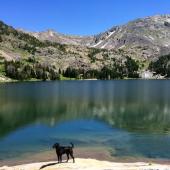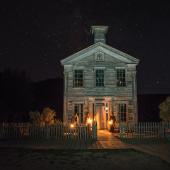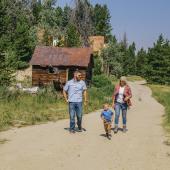Open Book
Paradise Valley's geologic story.
The Earth is estimated to be 4.56 billion years old, so what we see in our short lifetimes is a mere blip in geological time. Fortunately, Montana's majestic mountains, valleys, and lakes can tell the tale of long ago. Earth’s geologic record can be likened to a book, except it needs to be read from the back to the front. The rocks we see today explain the earlier chapters of earth’s history, so buckle up and let’s take a scenic drive through Paradise Valley and back in time.
Heading south from Livingston, the highway flows through a narrow canyon. The canyon’s rock sides reveal sedimentary layers that have been shoved, folded, and forced upward. In the 1940s, the US Army Corps of Engineers wanted to build a dam in this narrow opening. An outcry to save the scenic beauty and agriculture of the valley grew quickly. Ultimately, however, it was the local geology that ended the project before it began. Unstable limestone and crumbly shale were to blame.
The Gallatin Range runs on the west side of the valley, with the Absarokas flanking the east. Volcanic eruptions and ground-shifting forced the basement rock (or bottom geologic layer) upward and formed the mountain ranges. Glaciers then fine-tuned their artistry by carving out lakes, shearing mountainsides, and leaving glacial debris in low ridges called moraines.
Hepburn Mesa (chalk cliffs) is a captivating multi-layered cliff. The main white layer is siltstone formed from old lake deposits. Many vertebrate fossils have come from this section. Above the white cliffs is a dark grey/brown layer forming the skyline. This is one-million-year-old basalt formed into columns. Think six-sided stop-sign-shaped columns. These are formed when lava is rapidly cooled at or near the surface. Hepburn Mesa can be viewed from the rest area on the east side of Hwy. 89, 29 miles south of the I-90 exit in Livingston. Binoculars are a perk at this location.
Devil’s Slide is a colorful formation just south of Yankee Jim Canyon on the west side of the road. It looks like a giant red children’s slide. Over time, multiple layers of rock formed a multi-colored horizontal sedimentary layer called Chugwater mudstone. Compression and volcanic activity forced the once-horizontal layer up until it is almost vertical.
There are many more tales to be told from the rocks of Paradise Valley, but one thing is clear: destructive volcanoes played an important part in the beauty that we see.
Pattie Albrecht is the owner of Earth’s Treasures, a gem, jewelry, and fossil shop in downtown Bozeman. Stop in or visit them online at earthstreasuresmt.com.












